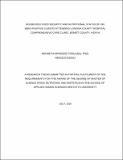| dc.description.abstract | Food insecurity remains a major problem in poor households, and its implications worsen
in disease states including Human Immunodeficiency Virus (HIV) and AIDS. More than
10 million Kenyans are chronically food insecure and 1.6 million have HIV. A
synergistic relationship exists between food insecurity, HIV, and AIDS. Human
Immunodeficiency Virus and AIDS cause an imbalance of the four fundamental elements
of food security: food access, availability, utilization, and stability. There is limited
literature on household food (in) security and nutritional status of HIV sero-positive
clients drawn from areas that have in recent times reported poor food production. Bomet
County recently experienced poor production of county’s staple: maize, due to the
emergence of Maize Necrosis disease, which resulted in increased harvest losses. The
main purpose of the study was to assess the household food security and nutritional status
of HIV sero-positive clients attending Comprehensive Care Clinic at Longisa County
Hospital, Bomet County. The study used a cross-sectional analytical design on a
comprehensive sample of 210 adult HIV sero-positive clients. A structured questionnaire
was used to collect data on socio-demographic and socio-economic factors,
anthropometric measurements, dietary intake, and food security status. Analysis was
done using descriptive statistics, which included means, percentages, standard error of the
mean, and frequencies. Pearson-moment correlation was used to establish strength of
associations between continuous variables and Chi-square for relationship between
categorical variables. Independent-Samples t-test was used to ascertain the existence of
significant differences in the study variables across the male and female gender
categories. One-Way ANOVA was used to determine the existence of significant
difference in the means of categorical variables and non-categorical variables. A p-value
of < 0.05 was used as the criterion for statistical significance. Data drawn from 24-hour
dietary recall was analysed using Nutri-survey. SECA calculator model 491 was used for
accurate determination of the Body Mass Index (BMI). Majority of the respondents:
(61.6%) were females. Adequacy in meeting energy requirements was 47.4% for males
and 50% for females. Males and females met the dietary needs for selected nutrients:
vitamin A, B1, B2, C. Iron intake was significantly low among female respondents
whereby 89.3% did not meet the RDI and zinc intake among male respondents was low
as only 28.9% met the RDI. Consumption frequency of meats, eggs, and fish was
irregular. Household food insecurity prevalence was 17.7% as evidenced by a Household
Dietary Diversity Score (HDDS) of ≤4. About 23.7% of the respondent’s households had
severe household hunger. Mean Household Hunger Scale score was 1.56±0.061
indicating that most of the respondent’s households experienced moderate household
hunger. The prevalence of underweight was 22.8%. There was a significant relationship
between nutritional status measured by BMI and household food security status measured
by HDDS at p=0.001. Household food security status measured by HHS and nutritional
status as assessed by MUAC had a positive association at p=0.001. Dietary intake and
nutrition status did not exhibit any relationship. The study recommends the need to scale
up care and treatment modalities at Comprehensive Care Clinics (CCC’s) by considering
and including household food security and nutritional status aspects as part of nutritional
care and support modalities for HIV sero-positive clients. This provides an ample means
of optimizing ART, enhancing rehabilitation, and adherence to care and treatment | en_US |

